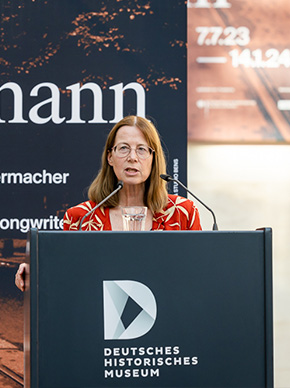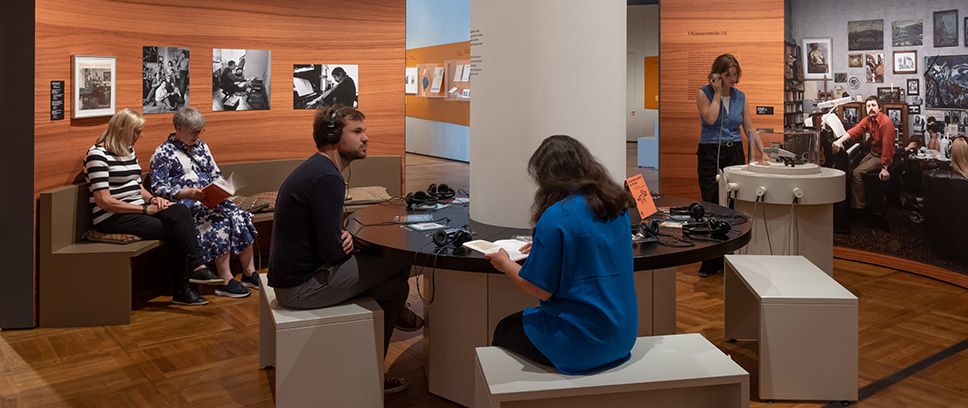
The Poet and Musician Wolf Biermann
Monika Boll | 27 September 2023
The architecture of the exhibition “Wolf Biermann. A Poet and Songwriter in Germany” is inspired by the body of a guitar. The exhibition’s media installation throws light on Biermann’s songs, poems and ballads in the mirror of art criticism. Curator Monika Boll focuses on the poet and songwriter and discusses his artistic work in this article.
When you enter the interior room of the exhibition, where the concave and convex curves of the walls resemble the body of a guitar, you come upon a large media station where the sound hole of the guitar is located. This installation is based on the idea of treating Biermann specifically as an artist. The political aspect of Biermann’s works is usually foremost in the public perception of the songwriter, whereby the artistic side of his lyrics and music is less often stressed. Therefore the exhibition and its companion book have taken on the task of looking not only at the political aspects but also closely examining the aesthetic side of his works. In her article in the companion publication, the literary scholar Hendrikje Schauer points out that Wolf Biermann’s first poetry collection, “Die Drahtharfe” (The Wire Harp), which was published by Wagenbach Verlag in West Berlin in 1965, remained for a long time the best selling German poetry volume after 1945. Biermann’s references to François Villon, Heinrich Heine and Bertolt Brecht were recognised at this early time. The tension between the dissident “I” and the collective “We”, concludes Schauer, creates a unique cadence with which Biermann self-assuredly lays claim to a place in post-1945 German-language lyricism.1 On the other hand, the musicologist Sabine Sanio concentrates on the musician Biermann. In her essay, she assesses Biermann’s affinity to, but also distance from, the tradition of the romantic art song and the French chanson and deals with the question of Biermann’s musical relation to the composer Hanns Eisler.
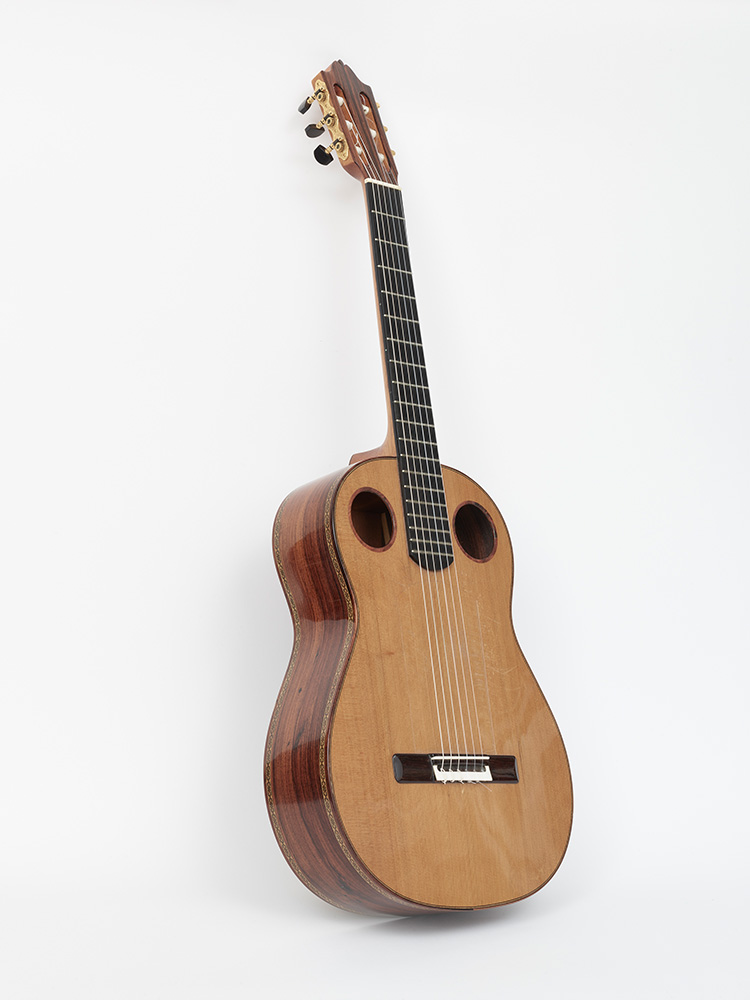
The media installation in the exhibition’s interior room also focuses on Biermann’s artistry. 21 songs, poems and ballads are introduced from the perspective of art criticism. These works were written between 1962 and 2013 and comprise almost the entire range of Biermann’s oeuvre. They include the early works “Ballade von dem Drainage-Leger Fredi Rohsmeisl aus Buckow” and “Deutschland, ein Wintermärchen”, followed by “Der Hugenottenfriedhof”, “Enfant perdu” and “Ballade vom preußischen Ikarus”, and on up to the later work “Um Deutschland ist mir gar nicht bang” and the song “Ach, die erste Liebe”, recorded together with Pamela Biermann in 2013. The contributions of the critics, voiced by the actors Anna Dramski and Romanus Fuhrmann in cooperation with RBB-Kultur, represent an equally broad range of evaluations of the poet and songwriter Wolf Biermann.
Here we find, for example, the reaction of the writer Stephan Hermlin to the controversy that erupted around Biermann’s poem “An die alten Genossen” (To the old comrades). In 1962, Hermlin organised the event “Young Lyric Poetry” in the Academy of Arts. What started as an outspoken debate about Biermann’s poem and the literary policy of the newspaper Neues Deutschland escalated into a scandal, resulting in Hermlin’s dismissal as head of the Academy. In a statement, Hermlin later requested the SED Party not to dispense with Biermann altogether, considering his great talent. This was a kind of precautionary protective measure, but it failed to save him from a subsequent ban on all public performances. An aesthetic rather than political debate about Biermann’s works took place primarily in the West. Early on, Dieter E. Zimmer, the arts editor of the newspaper DIE ZEIT, proclaimed Biermann as one of the “most vital and talented poets of these years.” The literary critic Marcel Reich-Ranicki spoke of the “convincing clarity” of Biermann’s lyricism and praised the ballad of the Prussian Icarus as one of his most beautiful poems.
The music editor Hans-Klaus Jungheinrich paid close attention to the singer with his “raw, croaky, seemingly boozy, and yet endlessly nuanced voice” and celebrated his song “Enfant perdu” as “impressive, disconcerting musical theatre.” There are also voices critical of Biermann to be heard in the media installation. The journalist Sybille Plogstedt, for example, attacks Biermann’s lyrics as “sexist and smutty”, and the poet Peter Rühmkorf fears, after the publication of the LP “Liebeslieder” in 1976, that “the established protester has resigned himself to playing his own role.”
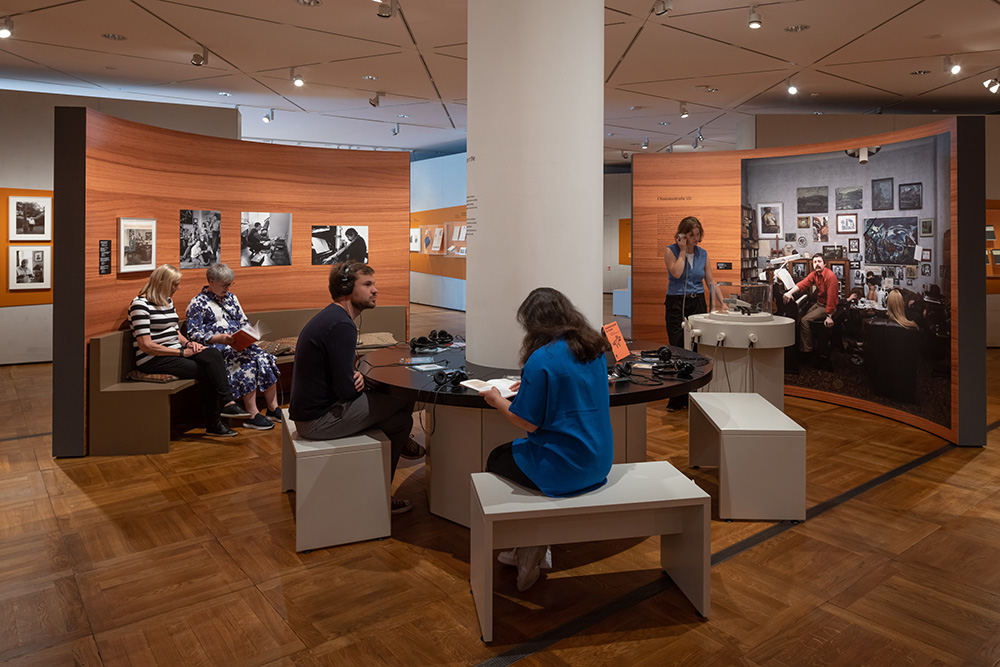
Similarly, in 2000, Steffen Jacobs came to the verdict that he could detect “very little potential agitation in Biermann’s raw resistance tone.” By contrast, the musicologist Sabine Sanio attested in 2022 that she found a “subtlety of sound” in Biermann’s music because it consciously abstained from sounding beautiful or merely illustrating the text.
Biermann’s music is closely connected to his passion for beautiful and unusual instruments. In the interior room of the exhibition, where the bridge of the guitar is located, there are three musical instruments from Biermann’s private collection: a harmonium, which he had already used in his flat in Chausseestrasse, a German hurdy-gurdy built by the instrument maker Hans Zölch, and one of Biermann’s guitars, model La Caprice from the workshop of Curt Claus Voigt. To get a idea of the sound of the hurdy-gurdy, you should definitely listen to “In China hinter der Mauer”. But there is no need to specially mention Biermann’s guitar playing – it’s ubiquitous throughout the exhibition.
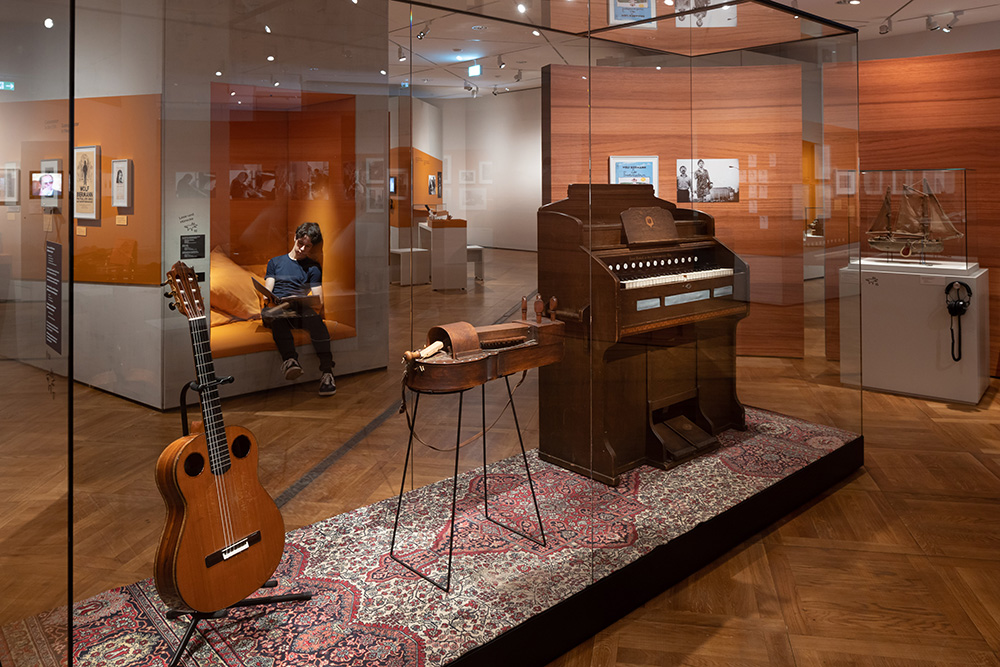
1 Hendrikje Schauer: Der Sound der Drahtharfe, in: Wolf Biermann. Ein Lyriker und Liedermacher in Deutschland, ed. Dorlis Blume, Monika Boll, Raphael Gross, Berlin 2023, p. 78ff.
|
|
Monika BollMonika Boll Monika Boll is a philosopher and curator. She has curated exhibitions at various museums on the Frankfurt School, Marcel Reich-Ranicki and Fritz Bauer, among others. For the Deutsches Historisches Museum Berlin, Monika Boll already curated the exhibition “Hannah Arendt and the 20th Century” in 2020. |
